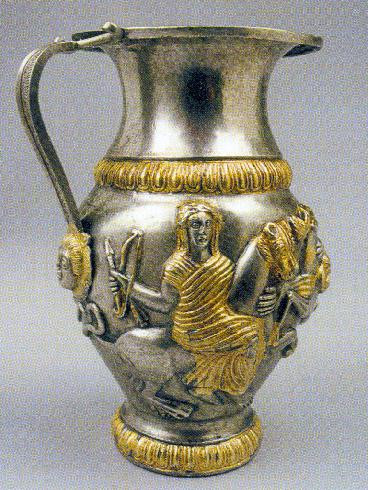In the peaceful village of Rogozen, located in the northwestern region of Bulgaria, an extraordinary archaeological discovery has illuminated the fascinating and mysterious world of ancient Thrace—a civilization that flourished in the Balkans for centuries yet remains largely shrouded in myth and legend. Among the most captivating items unearthed from this historic site is a remarkable silver jug, believed to date from between 400 and 300 BC. This artifact is not only a masterful example of ancient craftsmanship but also a window into the spiritual and cultural life of the Thracian people. The jug’s detailed design and symbolism have drawn the attention of historians, archaeologists, and art lovers across the globe, providing a rare glimpse into a bygone era and the values that shaped its people.

At the heart of this stunning silver vessel is an image that commands both awe and reverence—a powerful depiction of the Great Thracian Goddess, a central figure in the region’s mythological traditions. She is portrayed as a winged Mistress of the Animals, gripping two ferocious wolves in her hands. The symbolism here is rich and multifaceted. This goddess represents not just dominion over the wild but also the protective and nurturing aspects of nature. In Thracian belief, such deities served as guardians of both the people and the land, acting as intermediaries between the human world and the forces of nature. The inclusion of wings elevates her to a divine, almost ethereal status, while the wolves reflect the raw, untamed power of the wilderness she controls.
The artistry of the jug speaks volumes about the advanced metalworking skills possessed by the Thracians. The goddess’s wings are rendered with delicate precision, each feather meticulously shaped to convey motion and grace. The wolves, meanwhile, are depicted with a lifelike ferocity—their snarling mouths and tense muscles suggesting imminent action. The entire composition reflects not only technical prowess but also a deep understanding of artistic storytelling. The choice of silver, a precious and highly valued metal in the ancient world, further underscores the jug’s likely significance in religious or ceremonial contexts. This was no mere household item; it was likely used in rituals or as an offering to the gods, imbued with spiritual importance and reserved for special occasions.
Beyond its artistic merit, the silver jug offers crucial insights into the beliefs and daily lives of the Thracian people. It is a tangible expression of their worldview—a culture intimately connected to nature and the spiritual realm. The emphasis on animals and deities suggests that the Thracians viewed the natural world not as something to dominate, but as a living force to be respected and venerated. The presence of similar motifs in other Thracian artifacts, such as weapons, jewelry, and pottery, supports the idea that this reverence for nature was a core component of their identity. Moreover, the style of the jug reveals influences from neighboring civilizations, including the Greeks and Persians, indicating a vibrant cultural exchange that enriched Thracian art and religion. These interactions likely played a role in shaping the unique iconography and beliefs that set the Thracians apart.
The jug is just one piece of the broader Rogozen Treasure, a collection of over 165 silver and gold vessels discovered in 1985—a find that ranks among the most significant in Bulgaria’s archaeological history. This treasure trove includes cups, jugs, and plates, each adorned with intricate designs and motifs that reflect the wealth, power, and artistic sophistication of Thracian society. The collection has become a cornerstone for the study of Thracian culture, shedding light on their social hierarchy, religious practices, and interactions with the ancient world. The silver jug, in particular, stands out for its remarkable condition and the clarity of its imagery, making it an invaluable artifact for scholars and a source of fascination for the public.
As we continue to explore and interpret the Rogozen Treasure, the silver jug remains a powerful symbol of the richness and diversity of human history. It challenges modern audiences to consider the depth and complexity of ancient civilizations that have long been overlooked or misunderstood. Through its craftsmanship and symbolism, the jug tells a story of a people who found meaning and strength in the natural world, who expressed their beliefs through art, and who contributed to the cultural tapestry of the ancient Mediterranean in ways we are only beginning to understand.
In conclusion, the silver jug from Rogozen is far more than a relic of the past—it is a testament to the enduring human spirit and our timeless drive to create, to believe, and to connect with the world around us. It reminds us that every artifact, no matter how small or ancient, carries within it the echoes of lives once lived, of societies that shaped the course of history, and of the shared heritage that unites us all. As we uncover more about the Thracians and their place in history, this silver jug continues to inspire curiosity, respect, and a deeper appreciation for the artistry and spirituality of ancient peoples.





